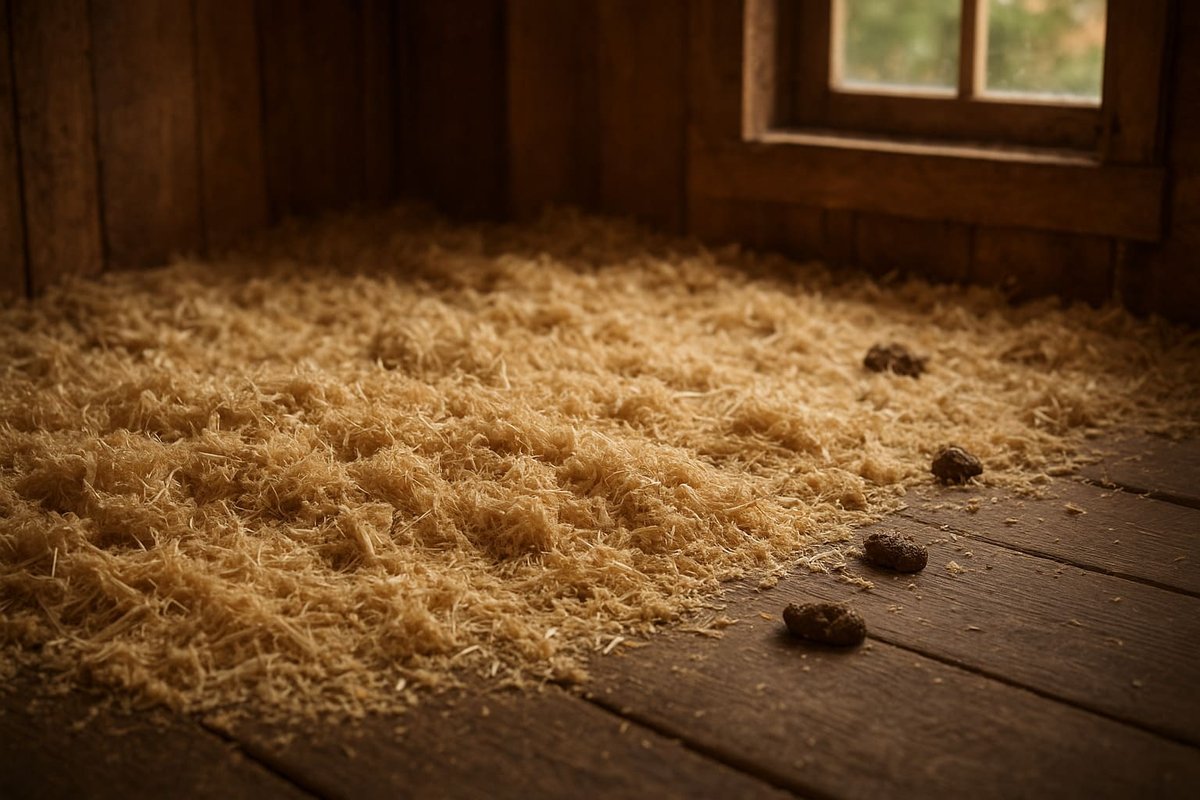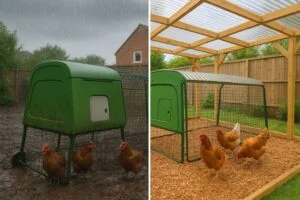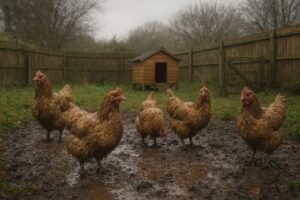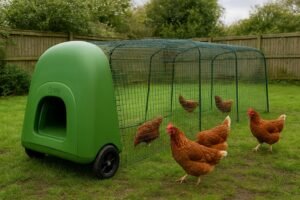Keeping chickens in the UK is brilliant, isn’t it? You get fresh eggs, funny little personalities to watch in the garden, and a bit of the good life. But let’s be honest: the Great British weather can be a total nightmare for coop management.
If you’re a backyard chicken owner, especially in damp regions like Wales, Scotland, or the rainy North West, you know the struggle. That constant drizzle and humidity turns coops into damp, muddy messes, which often leads to a muddy chicken run. And a damp coop isn’t just smelly—it’s a breeding ground for mould, bacteria, and the dreaded red mites.
Finding the best bedding for chickens uk is your number one weapon against damp. Get it right, and your hens stay healthy, warm, and comfy. Get it wrong, and you’re fighting a losing battle against soggy straw and health problems. Per BHWT 2025 advice, absorbent bedding is key for UK welfare standards to prevent damp-related diseases.
It’s a question I hear all the time: “What is the best type of bedding for chickens?” “Is sawdust or straw better for chickens?” “And seriously, how to keep moisture down in a chicken coop when it won’t stop raining?”
Don’t worry, I’ve got you. As a UK chicken keeper who’s battled my fair share of damp winters, I’ve tried pretty much everything. This guide is your ultimate answer. We’llwalk through the best (and worst) options for our unique climate, so you can pick the perfect bedding and keep your flock happy.
Understanding Chicken Bedding Needs in the UK Climate
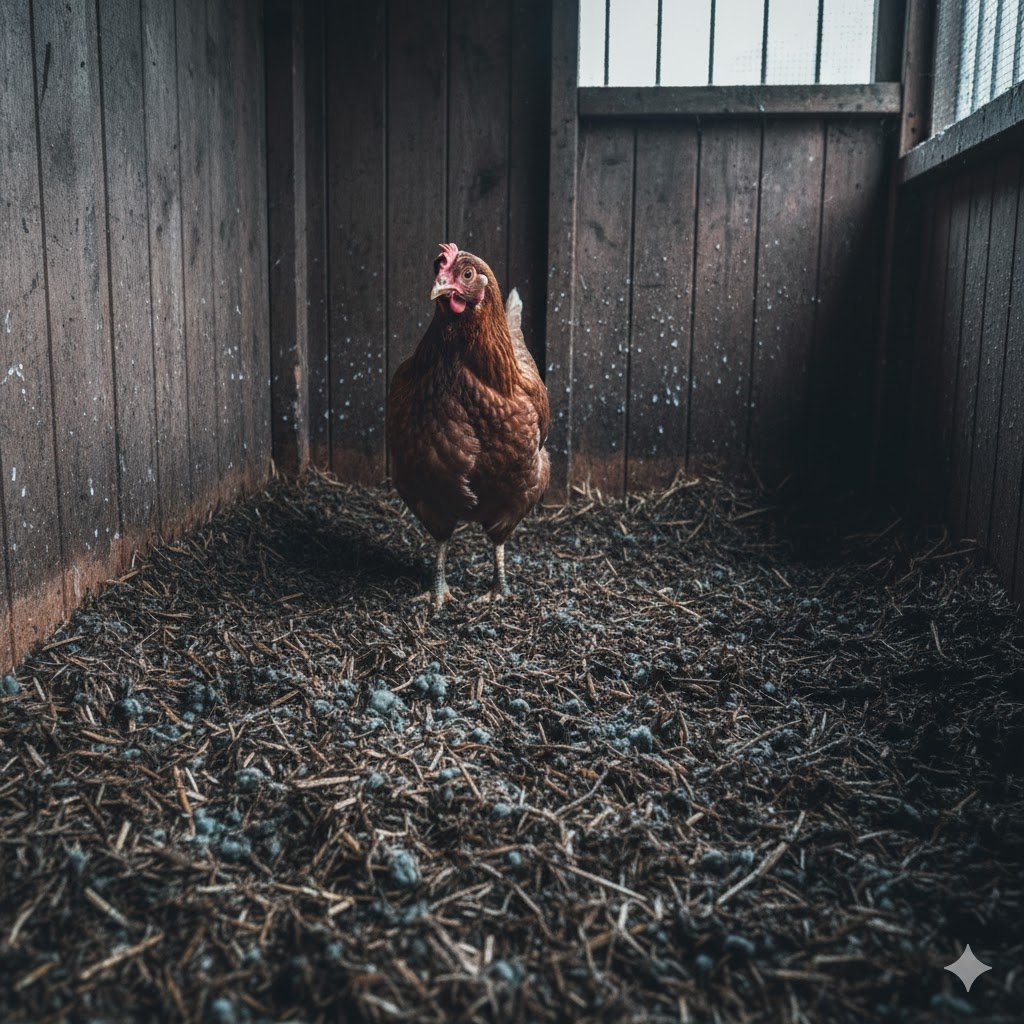
Your chickens add to this. They breathe out moisture all night, and their droppings are about 80% water. Damp bedding encourages harmful bacteria that release ammonia, damaging chickens’ respiratory systems, as Poultry Keeper explains. This can also lead to bad smells, so learning how to keep a chicken coop from smelling is crucial.
This is where bedding comes in. Good chicken bedding uk has three main jobs: According to the British Hen Welfare Trust, absorbent bedding is essential for UK chicken welfare.
- Absorb Moisture: It needs to soak up droppings and any rain that gets blown in.
- Provide Comfort: It’s a soft layer for your hens to walk and sleep on. RSPCA welfare standards mandate bedding must be clean and dry with adequate depth to protect chickens’ feet and overall health.
- Insulate: It adds a layer of warmth, especially on the best bedding for chicken coop floor.
Many guides are written for climates with cold, dry winters. They’ll tell you to pile up straw for insulation. In the UK, that’s often bad advice. Thick, non-absorbent straw in a damp UK coop just turns into a soggy, mouldy mat.
So, what should I line the bottom of my chicken coop with? You need something that puts absorption first. This choice is just as important as picking the best flooring for a chicken coop itself. Under DEFRA’s Code of Practice for Poultry Welfare, keepers must ensure housing supports hen health, which includes using appropriate bedding to manage moisture.
What Is the Best Bedding for Chickens UK? Top Recommendations
I’ve tested the most popular options on the market. Here are my top recommendations, ranked from best to worst for managing UK dampness.
1. Hemp Bedding (The Damp-Buster)
- Best for: Absorption, low dust, preventing mites.
- Brands: Aubiose, Easichick. Aubiose hemp bedding is specially processed to maximize absorbency, keeping chickens warmer and drier than traditional materials, according to the manufacturer’s specifications.
- Cost: Aubiose hemp absorbs 6x more than shavings, per 2025 product specs—great for our wet weather. Costs ~£12-£15 for a 20kg bale.
Honestly, hemp chicken bedding uk is a total game-changer for our climate. It’s made from the soft, woody core of the hemp plant and it’s incredibly absorbent—it can soak up to four times its own weight in liquid.
When it gets wet, it clumps, making it super easy to spot-clean. But its real strength is how it dries. It releases moisture back into the air, which your coop’s ventilation can then carry away. This stops the bedding from ever getting truly soggy.
- Pros:
- Amazingly absorbent.
- Dries out fast.
- Low dust (great for hens’ breathing).
- Naturally repels mites and pests.
- Composts down quickly, making it a great biodegradable bedding choice.
- Cons:
- It’s one of the most expensive options.
- Can be harder to find in local pet shops (though easy online).
Verdict: If damp is your main enemy, hemp bedding for chicken coop use is the best investment you can make. Experienced UK keepers like Kevin O’Hara from Keeping Chickens UK also rate hemp as the top choice for British coops. It’s the cleanest bedding for a chicken coop in my experience.
2. Wood Shavings (Pine – The Popular All-Rounder)
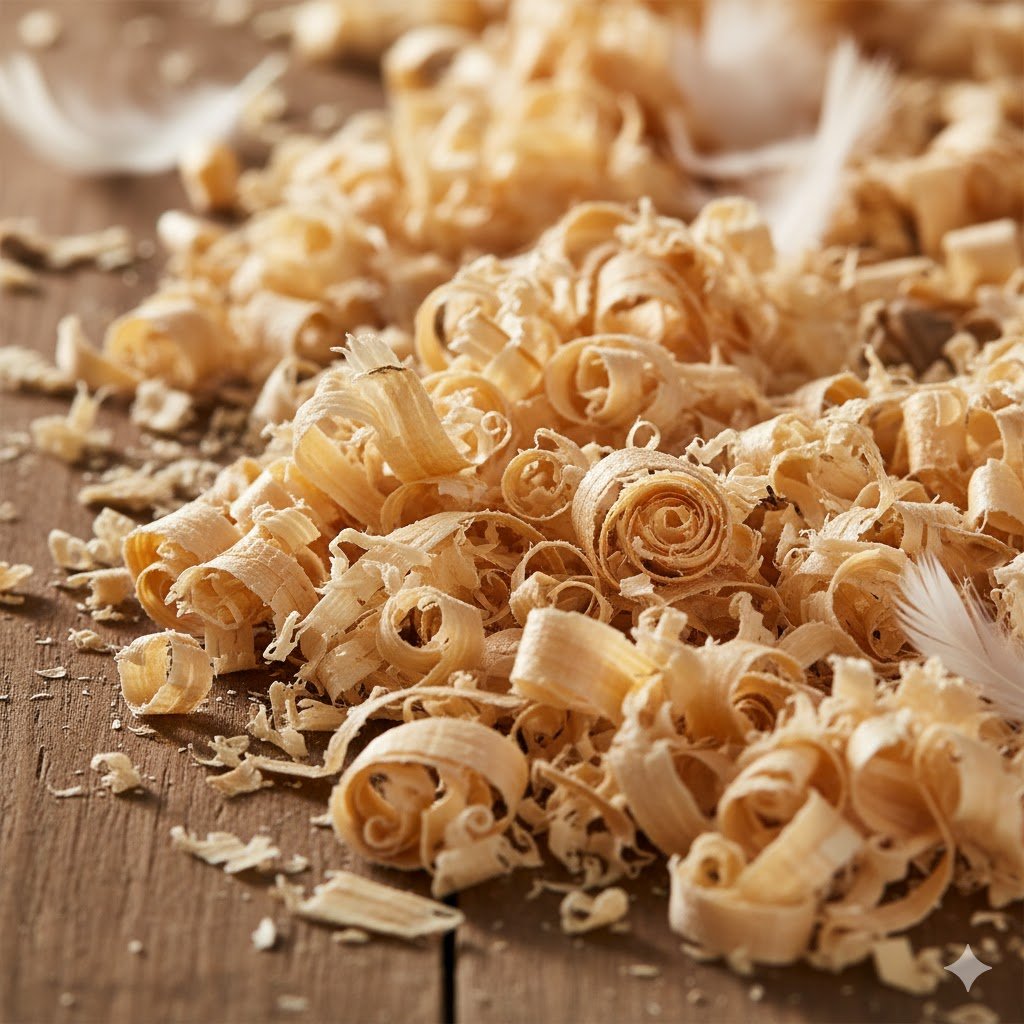
- Best for: Good value, easy to find, decent absorption.
- Brands: Look for “dust-extracted” pine shavings (e.g., Snowflake, Hunters).
- Cost: ~£8-£10 for a large bale.
Chicken bedding wood shavings (specifically pine, not cedar) are probably the most popular choice in the UK. You can find them everywhere, from Chicken Bedding Pets at Home to your local feed store.
They are pretty good at soaking up moisture and provide a nice, fluffy bed for your hens. The natural oils in pine are also said to help repel mites, which is a big bonus.
Crucial tip: You must buy dust-extracted shavings. Regular sawdust or cheap shavings are full of fine dust that can cause serious respiratory problems for your chickens.
- Pros:
- Widely available and affordable.
- Good absorbency.
- Smells nice and fresh (the pine scent).
- Mites aren’t keen on the pine oils.
- Cons:
- Can be very dusty if you buy a cheap brand.
- Can get matted and soggy if left too long.
- Can be slow to compost.
Verdict: A solid, reliable all-rounder. A great choice if hemp is out of your budget, but be fussy about getting a dust-free brand.
3. Straw (Chopped – The Insulator)
- Best for: Insulation in dry coops, nesting boxes.
- Brands: Dengie chicken bedding (chopped and treated), or standard farm bales. Dengie Fresh Bed for Chickens features dust-extracted chopped straw infused with pine oil for natural anti-bacterial properties, as their official specs detail.
- Cost: ~£5-£7 for a standard farm bale (chopped brands are dearer).
Ah, traditional chicken bedding straw. It’s the most popular, with a whopping 43% of people telling us this is their material of choice per the BHWT’s latest survey. This is what you picture on a farm, right? Straw is brilliant for insulation because its hollow stalks trap warm air.
But here’s the problem: it has almost zero absorbency.
In a damp UK coop, straw just gets wet, heavy, and compacted. It turns into a solid, soggy mat that’s a perfect home for mould and mites.
However, there’s a good way to use it:
- In Nesting Boxes: It’s soft, and hens love it for laying. It stays clean here.
- As a Top Layer: Use an absorbent base (like hemp or pellets) and put a light layer of chopped straw on top for warmth.
- Specialist Brands: Brands like Dengie chicken bedding are different. They are often chopped, dust-extracted, and sometimes treated (like Dengie’s ‘Fresh Bed’, which has essential oils). This makes them far better than a bale from a farm. Dengie Fresh Bed’s pine oil fights fungi, with 2025 reviews calling it ‘long-lasting’ for damp coops.
- Pros:
- Great insulation.
- Hens love to peck and scratch in it.
- Cheap (if you buy a standard bale).
- Cons:
- Terrible for absorbing moisture.
- Gets mouldy and horrible very fast when damp.
- Can harbour mites.
- Sourcing: Be careful buying standard farm bales for chicken bedding straw. They can sometimes be damp or musty before you even get them home. Always check for freshness.
Verdict: Avoid using standard straw as your main floor bedding in winter. Only use it in nesting boxes or as a light top layer over something absorbent.
4. Wood Pellets (The Super-Absorber Base)
- Best for: A super-absorbent base layer.
- Brands: Sold as horse bedding or for wood-fuel stoves (check they are 100% wood).
- Cost: ~£7-£10 for a 15kg bag.
These little pellets are made of compressed sawdust. When they get wet, they break down into a soft, fluffy, and incredibly absorbent sawdust.
Many UK keepers swear by them. The trick is to use them as a base layer on the best bedding for chicken coop floor. Put down a 1-inch layer, and then put softer bedding (like hemp or shavings) on top. The pellets will suck up any moisture that seeps through.
You can use them on their own, but they are very hard on chickens’ feet until they get damp and break down.
- Pros:
- Extremely absorbent.
- Very low dust when in pellet form.
- Composts well once broken down, another good biodegradable bedding option.
- Cons:
- Hard on feet until broken down.
- Can be heavy to carry.
- Not as cosy as other options.
Verdict: A fantastic base layer for dealing with extreme damp, but not the best as the only bedding.
5. Sawdust (Use With Caution)
- Best for: A cheap base layer, but only if dust-extracted.
Sawdust is just very fine wood shavings. It’s super absorbent, but it’s also super dusty. This is a real problem for your hens’ sensitive respiratory systems.
I would only ever use sawdust if it’s specifically sold as “dust-extracted” and even then, I’d probably use it as a thin base layer under something fluffier like hemp or pine shavings.
What Is the Best Type of Bedding for Chickens to Prevent Mites?
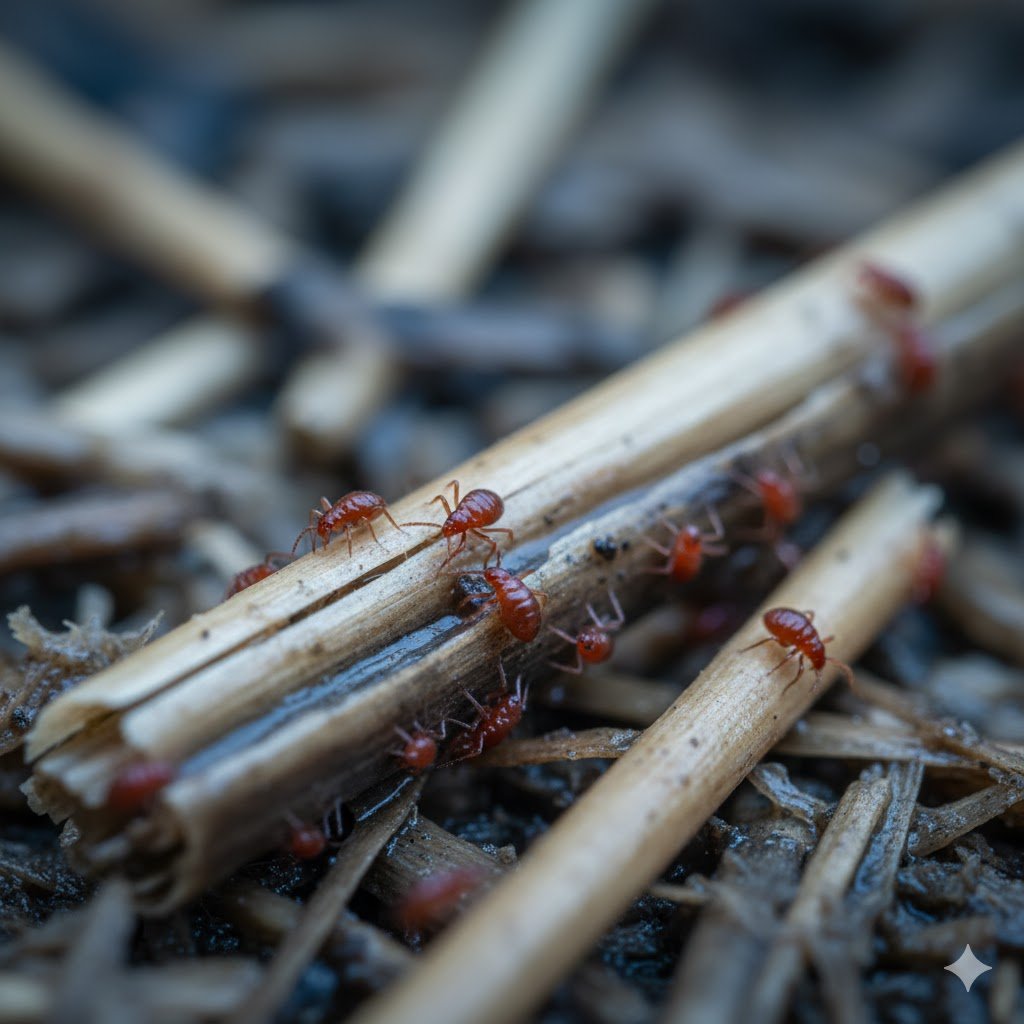
This is a key question for UK keepers. Red mites thrive in damp, warm cracks and crevices. Soggy, matted bedding is their idea of a luxury hotel. Getting rid of red mites in a wooden coop is a nightmare, so prevention is key.
The best bedding for chickens to prevent mites is one that stays dry and doesn’t provide a good hiding place. In my last really rainy spell, I’m convinced switching to hemp saved my flock from a serious mite outbreak—my neighbour who used straw wasn’t so lucky.
- Hemp: This is my number one choice. It dries out so fast that mites don’t get a chance to set up home. Its texture is also unappealing to them.
- Pine Shavings: The natural aromatic oils (phenols) in pine are a natural mite repellent. Mites just don’t like the smell.
- Diatomaceous Earth (DE): This isn’t bedding, but a powder you can add. It’s made of fossilised algae and kills mites by drying them out. Always use food-grade Diatomaceous Earth for chickens and wear a mask when applying it, as the dust is harmful to all lungs (yours and your hens’). Sprinkle it on the coop floor before adding fresh bedding. Combine with food-grade DE for extra prevention, but always mask up—BHWT tip.
A good bedding combined with a proper dust bath area for natural mite prevention is your best defence. The worst bedding for mites? Damp, clumpy straw. Avoid it!
Is Sawdust or Straw Better for Chickens? Full Comparison
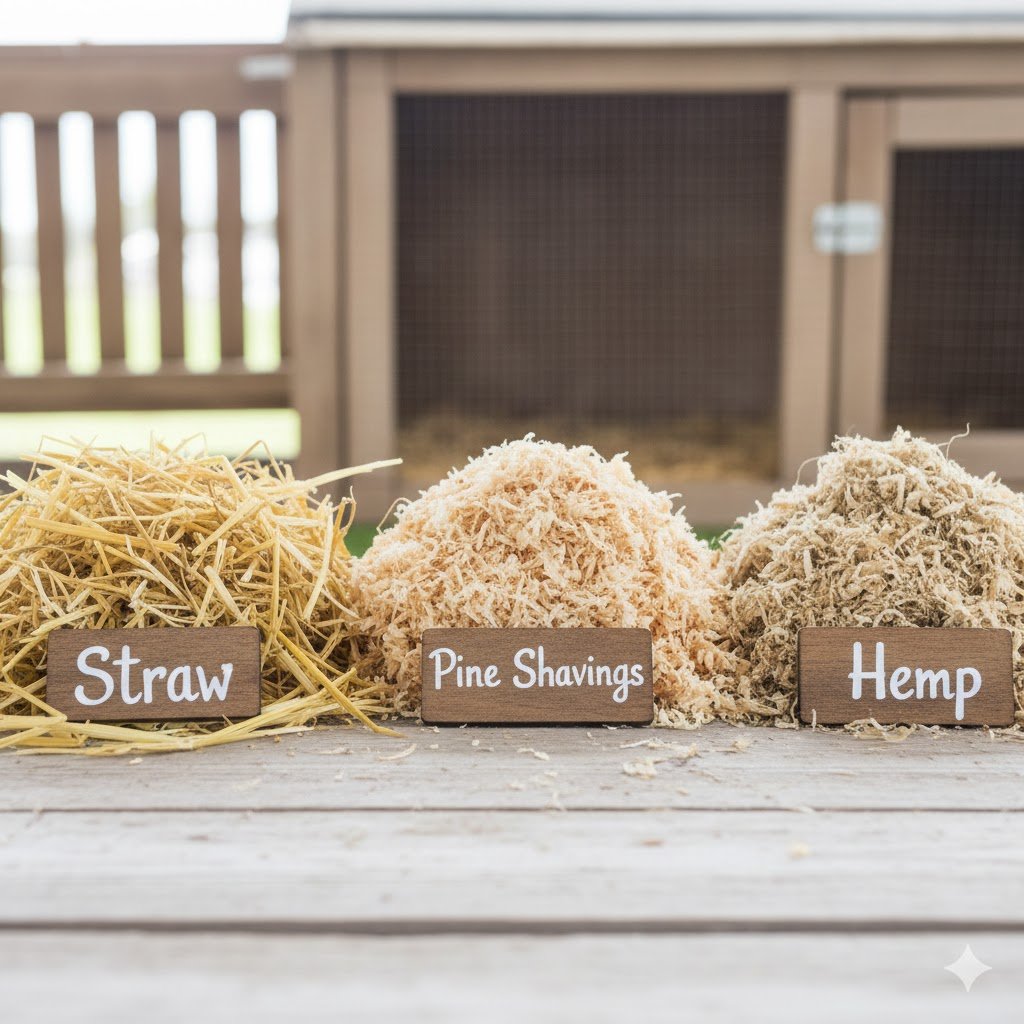
This is the big debate! Here’s a simple breakdown to answer “is sawdust or straw better for chickens?“
| Feature | Straw (Standard Bale) | Sawdust (Dust-Extracted) |
|---|---|---|
| Absorbency | Poor. Gets soggy and mouldy fast. | Excellent. Soaks up a lot of liquid. |
| Insulation | Excellent. Traps warm air. | Poor. Doesn’t offer much warmth. |
| Dust Level | Low (if chopped). | High risk. Can cause breathing problems. |
| Mite Risk | High. Mites love to hide in hollow, damp stalks. | Low. Too fine for mites to hide in. |
| Cost | Very Cheap. | Very Cheap. |
| UK Damp Suitability | Low. The worst choice for damp. | Medium. Good absorption, but dust is a risk. |
The Verdict:
- Straw is better for insulation but terrible for absorption.
- Sawdust is better for absorption but terrible for dust.
Honestly, in the damp UK climate, I wouldn’t recommend either as your main bedding. Both have serious downsides. Hemp or dust-extracted pine shavings are far better options that give you the best of both worlds: good absorption and low dust.
Best Bedding for Chickens in Winter & Managing Dampness
The best bedding for chickens in winter is one that insulates and manages moisture. This is why a combination (or “deep litter method”) works so well. A big part of winterizing your chicken coop is getting the bedding right.
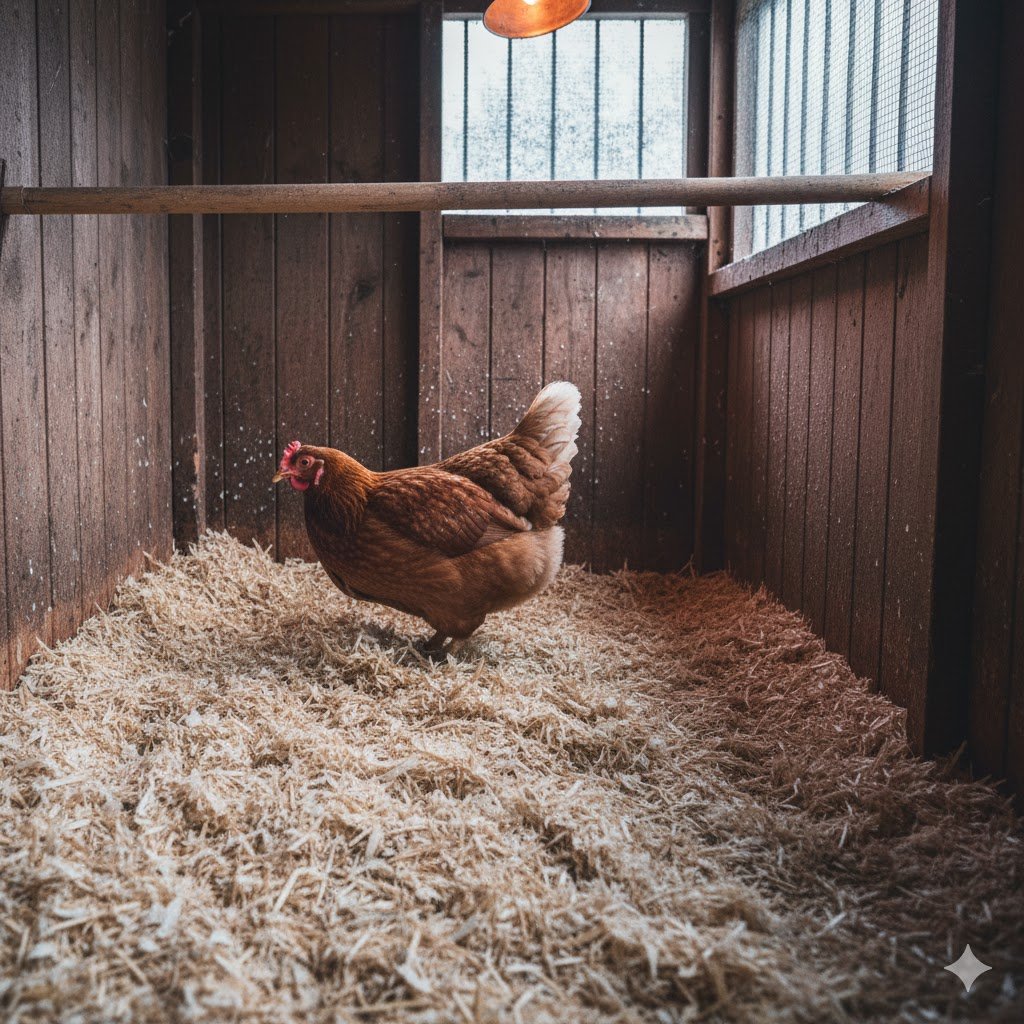
The Deep Litter Method is a great way to manage your coop in winter. Instead of cleaning out all the bedding every week, you just add more on top.
- Start with a 4-6 inch layer of high-absorbency bedding (like hemp bedding for chicken coop floors or pine shavings). This aligns with RSPCA recommendations for maintaining dry, comfortable conditions.
- Every few days, rake the bedding over to mix the droppings in.
- Add a fresh, thin layer on top each week.
- The bedding at the bottom starts to compost, which actually creates heat, warming your coop from the ground up! This process breaks down the waste, turning your biodegradable bedding into garden-ready compost over time.
- You only do a full clean-out once or twice a year.
In my Devon winters, deep litter with a hemp base kept things toasty without any full cleans until spring. This method only works if your coop has excellent ventilation. Which brings us to…
How to Keep Moisture Down in a Chicken Coop
You can have the best bedding in the world, but if your coop is a sealed plastic box, it will get damp. Bedding is only one part of the solution.
- VENTILATION! This is the most important rule. You need to know how much ventilation a chicken coop needs. You need vents high up (near the roof) to let damp, warm air out, and vents low down to let fresh air in. Make sure they aren’t creating a draught that blows directly on your perching hens. The UK government’s poultry welfare guidelines emphasize that proper ventilation is critical to prevent damp-related respiratory issues.
- Fix Leaks: Check your coop roof and walls. A small drip can soak your bedding overnight.
- Raise the Coop: Get your coop off the damp ground. Sitting it on paving slabs or bricks stops moisture from seeping up from the floor.
- No Water Inside: Keep the water drinker outside the coop, or use a nipple-style drinker that doesn’t spill.
- Daily Spot-Cleaning: Get a cat litter scoop and just scoop out the worst of the droppings or any wet patches each morning. It takes 30 seconds and makes a huge difference.
- UK tip: On very still, damp days, open the main coop door for an hour while your hens are out free-ranging. This allows for a proper “air-out” that ventilation alone can’t manage.
What Not to Use for Chicken Bedding? (Common Mistakes)
Please avoid these! They can cause real harm to your flock. Using the wrong bedding is one of the easiest ways to fail a chicken health check.
- Hay: This is the #1 mistake. Hay is food (dried grass), not bedding. When it gets damp, it rots and grows mould very quickly. This mould can cause a fatal respiratory disease in chickens called Aspergillosis.
- Cedar Shavings: Cedar wood (reddish colour) gives off strong aromatic oils that are toxic to chickens. They can damage their lungs. Always use pine shavings.
- Scented Bedding: Don’t buy bedding with added scents or chemicals. Chickens have sensitive systems.
- Wet or Mouldy Bedding: Never be tempted to “dry out” bedding that’s already gone mouldy. Get it out and bin it.
- Sand: Some American guides recommend sand. I strongly advise against it in the UK. Sand? Skip it in the UK—it freezes and holds bacteria in our mild, wet colds. It holds damp, freezes solid in winter, and gets full of bacteria. The British Hen Welfare Trust also advises against sand, citing absorbency issues in UK conditions. As noted by multiple UK experts, sand’s poor absorbency makes it unsuitable for our damp climate.
Where to Buy: Hemp Chicken Bedding UK, Dengie, and Pets at Home
You don’t need to look far for good bedding. Chicken Bedding Pets at Home options are convenient. They stock good-quality dust-free pine (~£6/bag) and hemp options; check for 2025 stock. Your local feed store is often the cheapest place for big bales.
Here’s a quick breakdown of what to look for:
| Type | Brand | Price (Approx. 2025) | Where |
|---|---|---|---|
| Hemp Bedding | Aubiose, Easichick | ~£12 – £15 (20kg) | Local feed/equestrian stores, Pets atHome, online. |
| Pine Shavings | Snowflake, Hunters | ~£8 – £10 (large bale) | Pets at Home, local feed stores, B&M, The Range. |
| Chopped Straw | Dengie Fresh Bed | ~£10 – £14 (treated bale) | Local feed/equestrian stores, some garden centres, online. |
| Wood Pellets | (Often unbranded) | ~£7 – £10 (15kg bag) | Equestrian stores, hardware shops (as fuel), B&M. |
- Local Feed Stores: This is often the cheapest place. They sell big bales of hemp (like Aubiose) and pine shavings for the horse market, which are perfect for chickens.
- Online: You can get anything delivered. Brands like Dengie chicken bedding (their ‘Fresh Bed’ is great) and Easichick (hemp) are all available online.
This is my experience-based guide, not veterinary advice. For health issues like mites, consult a UK vet or BHWT Helpline. Affiliates disclosed—no extra cost to you.
Conclusion: The Best Bedding for Your UK Flock
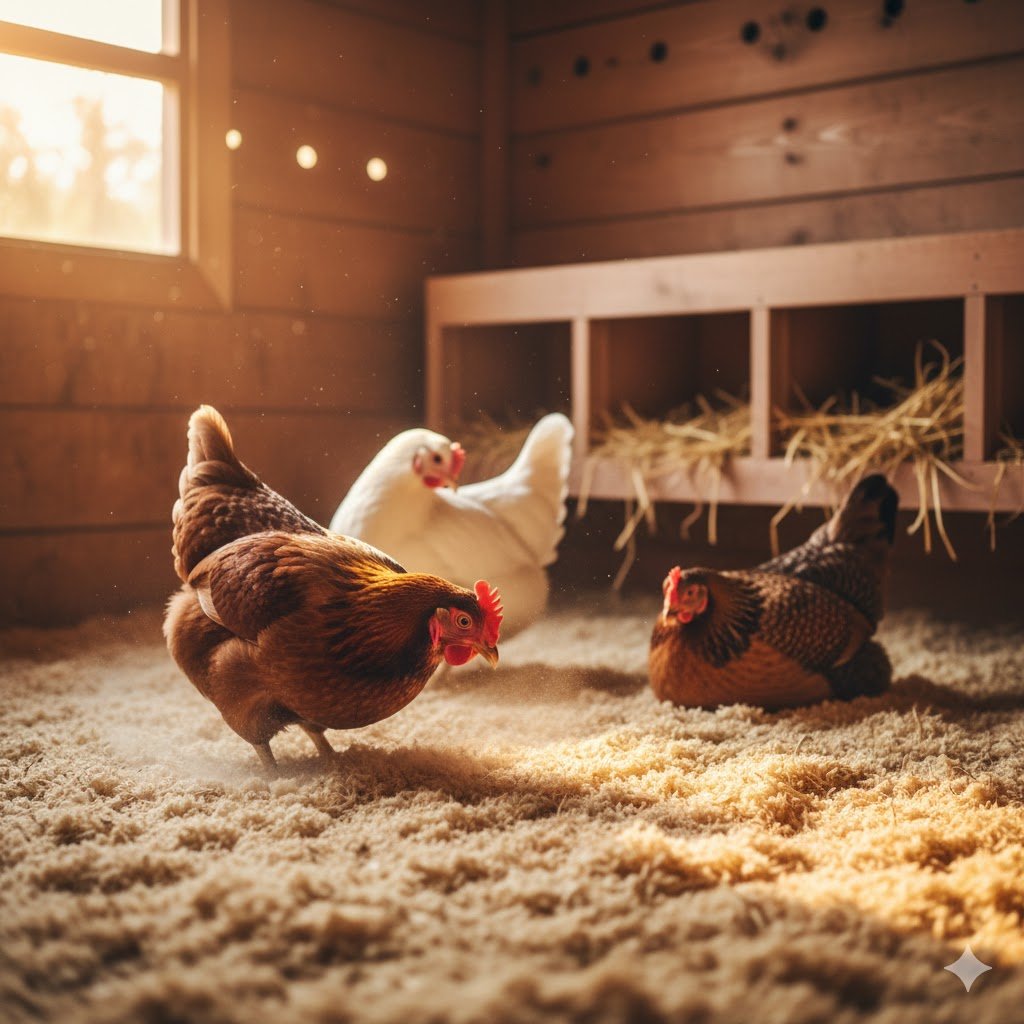
So, what’s the final verdict on the best bedding for chickens uk?
For my money, the clear winner for our damp, tricky climate is Hemp Bedding. It’s the most absorbent, lowest-dust, and best for keeping mites at bay. It makes managing a coop in a rainy winter so much easier.
If hemp is a bit pricey, my second choice is Dust-Extracted Pine Shavings. They are a fantastic all-rounder that’s affordable and easy to find.
Remember, the bedding is only half the story. You must have good ventilation and keep on top of your cleaning. Upgrading to an automatic chicken coop door can also help, as it ensures your coop is securely closed at night but open first thing for air circulation.
Keeping chickens in the UK is all about managing the damp. Get that right, and you’ll have a flock of happy, healthy hens all year round. Try hemp first for the best type of bedding for chickens in damp UK spots.
What do you use in your coop? Have you found a trick that works wonders? Let me know in the comments!
Frequently Asked Questions (FAQ) on Best Bedding for Chickens UK
Q: What is the best bedding for chickens UK?
A: Hemp for damp management, per experts.
Q: What is the best thing to put on the bottom of a chicken coop?
A: The best thing to put on the bottom of a chicken coop is a thick (4-6 inch) layer of highly absorbent bedding. Hemp or dust-extracted pine shavings are the best options. Some keepers like to put a layer of lino or vinyl on the wooden floor first to make it easier to scrape clean, but the bedding itself is what does all the work.
Q: What is the best material for the bottom of a chicken coop?
A: This is the same as the question above! The best material is an absorbent bedding like hemp or pine shavings. If you’re asking about the floor itself, wood is standard. Covering the wood floor with vinyl can make clean-outs easier.
Q: What is the cleanest bedding for a chicken coop?
A: The cleanest bedding for a chicken coop is one that is highly absorbent and low in dust. This is why hemp and dust-extracted pine shavings are the top choices. They lock away moisture and smells and are easy to spot-clean, which keeps the coop cleaner for longer. Straw is one of the least clean, as it gets dirty and mouldy very quickly.
Q: How often should I change bedding in the UK?
A: This totally depends on the weather and how many chickens you have!
Spot-Clean: You should scoop out the worst of the wet patches and droppings every day.
Full Clean: In a damp winter, you might need a full clean-out every 2-4 weeks.
Deep Litter Method: If you use this method (see above), you only do a full clean-out once or twice a year, but you must add fresh bedding weekly and have good ventilation.

Oladepo Babatunde is the founder of ChickenStarter.com. He is a backyard chicken keeper and educator who specializes in helping beginners raise healthy flocks, particularly in warm climates. His expertise comes from years of hands-on experience building coops, treating common chicken ailments, and solving flock management issues. His own happy hens are a testament to his methods, laying 25-30 eggs weekly.
